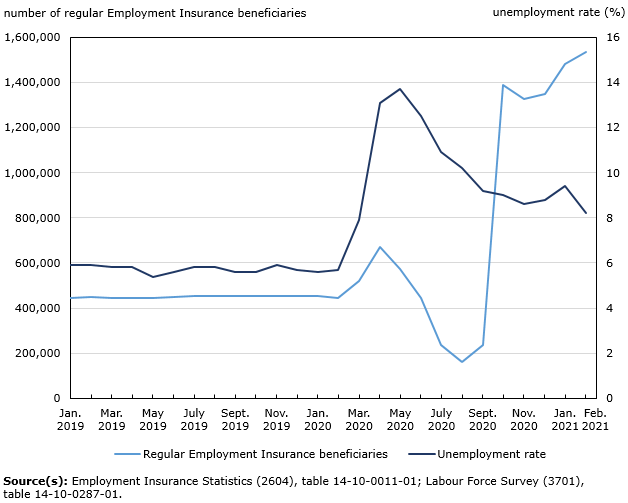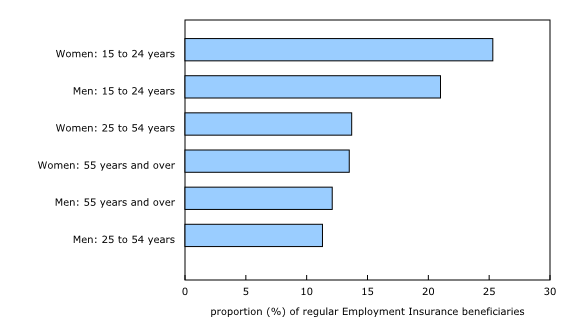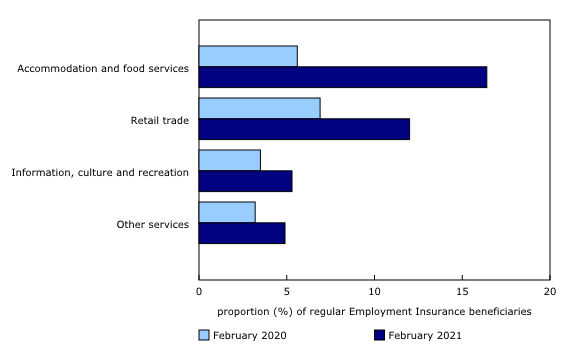Employment Insurance, February 2021
Archived Content
Information identified as archived is provided for reference, research or recordkeeping purposes. It is not subject to the Government of Canada Web Standards and has not been altered or updated since it was archived. Please "contact us" to request a format other than those available.
Released: 2021-04-22
February Employment Insurance (EI) statistics reflect labour market conditions as of the week of February 14 to 20.
Ahead of the February reference week, non-essential businesses, cultural and recreation facilities, and in-person dining reopened in many provinces, subject to capacity limits and various other public health requirements. Public health measures were relaxed in Quebec, Alberta, Nova Scotia and New Brunswick on February 8, although a curfew remained in effect in Quebec. Measures were loosened in many regions of Ontario on February 10 and 15, although stay-at-home orders remained in place in the health regions of Toronto, Peel, York and North Bay Parry Sound. In Manitoba, various measures were eased on February 12. In contrast, Newfoundland and Labrador reintroduced a lockdown on February 12, requiring the widespread closure of non-essential businesses and services.
Number of regular EI beneficiaries up in February
The number of Canadians receiving regular EI benefits rose 3.6% (+53,000) to 1.5 million in February, following an 11.2% increase in January. Results from the Labour Force Survey (LFS) indicate that employment increased 259,000 in February, following two months of losses, while unemployment fell to 1.7 million, including 1.4 million who were looking for work and 300,000 who had a connection to a job, either because they were on temporary layoff or had arrangements to begin a new job in the near future.
Female youth more likely than other age groups to qualify for regular EI under the new rules
In September 2020, temporary changes to EI eligibility criteria were introduced to support workers affected by the COVID-19 pandemic. In February, 14.2% of regular EI recipients—including almost one-quarter (23.0%) of those aged 15 to 24—qualified under these new eligibility criteria.
Number of regular EI beneficiaries increases in seven provinces
The number of regular EI beneficiaries rose in seven provinces in February, led by Ontario (+35,000; +6.3%), British Columbia (+18,000; +13.2%), and Newfoundland and Labrador (+10,000; +22.0%). Almost three-quarters of the increase observed in Ontario was attributable to regular EI beneficiaries who also worked at some point during the reference week, reflecting the loosening of public health measures in the province during that week.
Reflecting the reintroduction of strict public health measures in Newfoundland and Labrador, almost one in four individuals (22.6%) in the labour force in that province received regular EI benefits in February. The increase observed in Newfoundland and Labrador was almost entirely driven by EI beneficiaries who did not work during the reference week.
At the same time, Quebec (-18,000; -4.8%), Alberta (-2,000; -1.0%) and Manitoba (-1,000; -1.4%) posted decreases in the number of regular EI recipients.
On a regional basis, census metropolitan areas (CMAs) (+29,000; +2.8%) recorded the largest increase in regular EI recipients, followed by regions outside CMAs and census agglomerations (+15,000; +5.9%).
Industries most impacted by public health measures account for over one-third of regular EI recipients
According to February LFS results, employment remained below pre-COVID-19 levels in the industries most impacted by public health measures, including accommodation and food services (-26.1%); information, culture and recreation (-15.1%); other services (-6.0%); and retail trade (-5.4%). The profile of regular EI recipients further illustrates the impact of pandemic response measures on these same industries. In February, more than one-third (38.7%) of all regular EI recipients last worked in one of these four industries, compared with 19.4% one year previously (not seasonally adjusted).
Young women particularly hard hit by public health measures
In February, women accounted for a larger proportion of regular EI recipients in all age groups, compared with one year previously. The increase among female youth aged 15 to 24 years, who accounted for 44.9% of all youth regular EI beneficiaries, compared with 29.9% in February 2020, was particularly notable. Results from the February LFS show that year-over-year employment losses among young women were almost double those among young men, indicating that young women have been particularly hard hit by pandemic-related public health measures.
Sustainable development goals
On January 1, 2016, the world officially began implementing the 2030 Agenda for Sustainable Development—the United Nations' transformative plan of action that addresses urgent global challenges over the following 15 years. The plan is based on 17 specific sustainable development goals.
Employment Insurance statistics are an example of how Statistics Canada supports the reporting on the global sustainable development goals. This release will be used to help measure the following goal:

Note to readers
Employment Insurance in the context of broader COVID-19 benefit programs
No methodological changes were made to the Employment Insurance Statistics (EIS) program over the COVID-19 period. EIS reflect the Employment Insurance (EI) program for the Labour Force Survey (LFS) reference week in each month.
Data for the October 2020 reference period and onward consist of individuals who obtained EI benefits, and exclude beneficiaries of the Canada recovery benefits (Canada Recovery Benefit, Canada Recovery Caregiving Benefit and Canada Recovery Sickness Benefit).
Concepts and methodology
The analysis focuses on people who received regular EI benefits related to job loss.
EI statistics are produced from administrative data sources provided by Service Canada and Employment and Social Development Canada. These statistics may, from time to time, be affected by changes to the Employment Insurance Act or administrative procedures.
EI statistics indicate the number of people who received EI benefits and should not be confused with LFS data, which provide estimates of the total number of unemployed people. There is always a certain proportion of unemployed people who do not qualify for benefits. Some unemployed people have not contributed to the program because they have not worked in the past 12 months or their employment was not insured. Other unemployed people have contributed to the program but do not meet the eligibility criteria, such as workers who left their jobs voluntarily or those who did not accumulate enough hours of work to receive benefits.
All data in this release are seasonally adjusted, unless otherwise specified. Values for all series from March 2020 to February 2021 have been treated as outliers in the determination of a seasonal pattern for seasonal adjustment. For more information on seasonal adjustment, see Seasonally adjusted data – Frequently asked questions.
The number of regular EI beneficiaries for the current month and the previous month is subject to revision.
The number of beneficiaries is a measure of all people who received regular EI benefits from February 14 to 20. This period coincides with the reference week of the LFS.
Beneficiaries who qualified for EI under the new EI rules introduced in September 2020
Temporary changes to the EI program that provided all new regular EI beneficiaries with a one-time credit of 300 insurable hours were introduced on September 27, 2020. In addition, the unemployment rate used to calculate their eligibility and entitlement weeks was 13.1%, unless their region's unemployment rate was higher.
This supplementary indicator presents the number of individuals who qualified for EI only as a result of these program changes.
EI beneficiaries by industry
The industry of EI beneficiaries is determined through the integration of EI and record of employment administrative data. For beneficiaries with more than one record of employment in the past 52 weeks, the records with the greatest number of hours are used. If no industry information can be found, industry information is deemed "Not classified" for the beneficiary.
EI beneficiaries by number of months on EI or Canada Emergency Response Benefit over the last year
This supplementary indicator presents the number of regular EI recipients who received either regular EI benefits or the Canada Emergency Response Benefit (CERB) for a defined number of total months over the last 12 months.
A census metropolitan area (CMA) or census agglomeration (CA) is formed by one or more adjacent municipalities centred on a population centre. A CMA must have a total population of at least 100,000. A CA must have a population of at least 10,000. See Standard Geographical Classification 2016 – Definitions for more information.
Data availability
Data tables 14-10-0336 and 14-10-0337 remain suspended as of the December 2019 reference period, because of occupational coding issues from the source data file. Work is ongoing to identify a solution and continue publication of the tables.
Data tables 14-10-0004, 14-10-0005, 14-10-0007 and 14-10-0008 remain suspended as of the March 2020 reference period, because a source data file contains records for CERB claimants and beneficiaries that could not be identified and excluded through processing.
In the data table 14-10-0009, for the March to September reference periods, sub-aggregates of the parent "regular benefits" benefit type have been suppressed because of data quality.
Next release
Data on EI for March 2021 will be released on May 20, 2021.
Products
More information about the concepts and use of Employment Insurance statistics is available in the Guide to Employment Insurance Statistics (73-506-G).
Contact information
For more information, or to enquire about the concepts, methods or data quality of this release, contact us (toll-free 1-800-263-1136; 514-283-8300; STATCAN.infostats-infostats.STATCAN@canada.ca) or Media Relations (613-951-4636; STATCAN.mediahotline-ligneinfomedias.STATCAN@canada.ca).
- Date modified:






